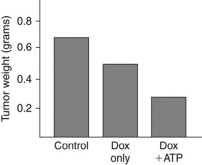Scenario
Biomedical scientists have recently developed an anticancer drug delivery system that sneaks the anticancer drug into cancer cells before releasing it. They were able to do this by using two sets of liposomes. An anticancer drug (Doxorubicin (Dox) ) bound to DNA molecules was added into one set of liposomes, and a high concentration of ATP molecules were added to the other set of liposomes. The drug is inactive when bound to DNA molecules. Researchers inject both types of liposomes into cancer cells, and upon doing so their contents are released. The ATP molecules from one set of liposomes bind to the DNA molecules from the other set of liposomes) and activate the drug, thus inducing cell death and decreasing tumor size.
Mice with breast cancer tumors were treated with this liposome system to test the effectiveness of the drug. The scientists performed three trials-one with both types of liposomes (Dox + ATP) , one with just the drug (Dox only) , and one with a salt solution (control) . Examine the figure below and answer the following questions. 
-A student in your class examines the graph and hypothesizes that ATP is what kills cancer cells, and not Dox. What follow-up experiment would allow you to test this student's hypothesis?
Definitions:
Osteocytes
Mature bone cells that maintain the bone matrix and are involved in the regulation of bone density.
Canaliculi
Small, channel-like structures in bone tissue that allow for communication and nutrient/waste exchange between osteocytes.
Osteons
The fundamental unit of compact bone, consisting of a central canal surrounded by concentric lamellae of mineralized matrix.
Lacunae
Small spaces, cavities, or gaps found in various tissues, often referring to the spaces in bone or cartilage that contain cells.
Q3: Mendel's law of segregation indicates that<br>A)two alleles
Q9: Which of the following typically would not
Q14: By definition, what type of fatty acid
Q26: Emily Haver is being seen by Dr.
Q32: A discrete packet of light is called
Q33: According to the sliding-filament model of muscle
Q34: Name at least three functions that are
Q46: What plant nutrients are shown in the
Q49: Which process is found in both cellular
Q54: The best definition of a purebred plant